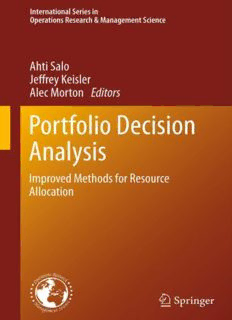
Portfolio Decision Analysis: Improved Methods for Resource Allocation PDF
Preview Portfolio Decision Analysis: Improved Methods for Resource Allocation
International Series in Operations Research & Management Science Volume 162 SeriesEditor FrederickS.Hillier StanfordUniversity,CA,USA SpecialEditorialConsultant CamilleC.Price StephenF.AustinStateUniversity,TX,USA Forfurthervolumes: http://www.springer.com/series/6161 Ahti Salo (cid:2) Jeffrey Keisler (cid:2) Alec Morton Editors Portfolio Decision Analysis Improved Methods for Resource Allocation 123 Editors AhtiSalo JeffreyKeisler AaltoUniversitySchoolofScience DepartmentofManagementScience SystemsAnalysisLaboratory andInformationSystems POBox11100 UniversityofMassachusetts,Boston 00076Aalto MorrisseyBoulevard100 Finland Boston,MA02125 ahti.salo@tkk.fi USA [email protected] AlecMorton DepartmentofManagement LondonSchoolofEconomics HoughtonStreet WC2A2AELondon UnitedKingdom [email protected] ISSN0884-8289 ISBN978-1-4419-9942-9 e-ISBN978-1-4419-9943-6 DOI10.1007/978-1-4419-9943-6 SpringerNewYorkDordrechtHeidelbergLondon LibraryofCongressControlNumber:2011932226 ©SpringerScience+BusinessMedia,LLC2011 Allrightsreserved.Thisworkmaynotbetranslatedorcopiedinwholeorinpartwithoutthewritten permission of the publisher (Springer Science+Business Media, LLC, 233 Spring Street, New York, NY10013, USA),except forbrief excerpts inconnection with reviews orscholarly analysis. Usein connectionwithanyformofinformationstorageandretrieval,electronicadaptation,computersoftware, orbysimilarordissimilarmethodologynowknownorhereafterdevelopedisforbidden. Theuseinthispublicationoftradenames,trademarks,servicemarks,andsimilarterms,eveniftheyare notidentifiedassuch,isnottobetakenasanexpressionofopinionastowhetherornottheyaresubject toproprietaryrights. Printedonacid-freepaper SpringerispartofSpringerScience+BusinessMedia(www.springer.com) Foreword Resource allocation problems are ubiquitous in business and government orga- nizations. Stated quite simply, we typically have more good ideas for projects and programs than funds, capacity, or time to pursue them. These projects and programsrequiresignificantinitialinvestmentsinthepresent,withtheanticipation of future benefits. This necessitates balancing the promised return on investment against the risk that the benefits do not materialize. An added complication is thatorganizationsoftenhavecomplexandpoorlyarticulatedobjectivesandlacka consistentmethodologyfordetermininghowwellalternativeinvestmentsmeasure upagainstthoseobjectives. The field of decision analysis (or DA) has recognized the ubiquity of resource allocation problems for three or four decades. The uncertainty of future benefits clearly calls for application of standard approaches for modelling uncertainties – such as decision trees, influence diagrams, and Monte Carlo simulation, and for using utility functionsto modeldecision makers’ risk preference.The problemof manyobjectivesisanopportunitytoapplymulti-attributeutilityorvaluemodels– or similar techniques – to decompose a difficult multidimensional problem into a series of relatively simple judgments about one-dimensional preferences and relativetrade-offweights.Applicationof thesemodelsinreal-worldorganizations alsorequiresstate-of-the-arttechniquesandprocessesforelicitingprobabilitiesand preferences, performing sensitivity analyses, and presenting clear and compelling resultsandrecommendations.Assuch,theseproblemsclearlyfallwithinthemain- streamofDAmethodsandpractice. However,incontrasttotraditionalDA,itisimportanttorecognizethatresource allocationis a portfolioproblem,where the decisionmakersmustchoose the best subset of possible projects or investments subject to resource constraints. Several other disciplines have also focused on the portfolioaspects of resource allocation problems, particularly operations research (OR) and finance. OR techniques such as mathematical programming are directly relevant to finding optimal portfolios of projectssubjectto resourceconstraints. However,mathematicaloptimizationis not typically considered part of routine DA practice, and combining the best of v vi Foreword decisionanalyticmodelswithmathematicalprogramminghasreceivedonlylimited attention. DA practitioners commonly solve portfolio problems with heuristic approaches,suchasprioritizationbasedonbenefit–costratios,despitefoundational workdonebyDonaldKeefer,CraigKirkwood,andtheircolleaguesinthe1970s.In finance,theconsiderablebodyofworkonapplicationsofORtofinancialportfolios is relevant to understanding trade-offs of risk and return. However, finance and DA use different approaches and make different assumptions for assessing and modellingriskpreferences. PortfolioDA also posessignificantpracticalchallenges.In largeorganizations, hundredsor thousands of projects and programsmay be considered for inclusion in a portfolio.Assessing multipleevaluationcriteriaacrosshundredsor thousands of projects can be daunting. If probability assessments are required, then good DA practice typically emphasizes careful and rigorous assessment and modelling of the uncertainties. This amounts to building hundreds of models and assessing probability distributions for many thousands of uncertain parameters. In my own experience working on resource allocation in hospitals, healthcare systems, and largemanufacturingfirms,theseorganizationssometimesstruggletodevelopeven straightforwarddeterministicfinancialmodelsfortheirprojects.Conductingafull- blown decision analysis for each project is simply infeasible. Stated quite simply, themostcriticalscarceresourcesaretheresourcesrequiredtoobtainandevaluate data, assess probabilities, construct models, and evaluate alternative portfolios of projects.Decisionmakerstypicallystartwithlimitedinformationabouteachproject andportfolio,andneedguidanceaboutwhichprojectstoanalyze,andatwhatlevel ofdetail. Given the ubiquity of portfolio problems, the rich intersection of multiple relevant disciplines, and the very real practical challenges associated with these problems,onewouldnaturallyexpecttoseedecisionanalystsrisetothechallenge. The applied side of the decision analysis profession appears to have responded – particularly in oil and gas production,pharmaceuticals, and military applications. Anumberofvendorshavealsorespondedbyprovidingcommercialsoftwaretools specificallydesignedtosupportportfolioDA. Despite the apparent success of portfolio DA in practice, there has been surprisingly limited attention to portfolio theory and methods in academic DA. With only a few notable exceptions, introductoryDA textbookseither provide no discussion of portfolio methodsand problems, or at best, a cursory overviewof a few applications. Nor has the theory and methods of portfolio DA received more than limited attention in the research literature. In recent years, in part to address thisrelativeneglect,AhtiSalo,JeffreyKeisler,andAlecMortonorganizedaseries ofinvitedsessionsatvariousnationalandinternationalconferences.Thesesessions brought together researchers and practitioners with a shared interest in portfolio decision analysis. I believe these sessions succeeded in encouraging academic- practitionercommunication,and perhapshave persuadedmore academic decision analyststofocustheirattentionofportfolioproblems,issues,andchallenges. This volume, Portfolio Decision Analysis: Improved Methods for Resource Allocation,isthenextlogicalstepinSalo,Keisler,andMorton’seffortstofostera Foreword vii richandproductiveinteractionoftheory,method,andapplicationinportfolioDA.I commendandapplaudtheeditors’objectives,andIampleasedtoseethattheyhave succeeded in attracting a diverse collection of contributions from a distinguished set of authors. The editors do an excellent job of providing an overview of these contributionsin their introductorychapter. I simply concludeby encouragingyou to take up where these authors leave off, either by furthering the developmentof newtheoryandmethods,orbyputtingthesetheoriesandmethodstothetestinreal organizationsstrugglingtomakethebestuseofscarceresources. StrataDecisionTechnology,L.L.C. DonN.Kleinmuntz,Ph.D. Champaign,IL,USA ExecutiveVicePresident Acknowledgments Thisbookistheresultofthecollectiveeffortsofmanypeople.Chapterauthorshave contributed in the most directly and tangible way; but there are many others who deservemention,notleastforhavingconvincedusoftheneedforadedicatedbook onPortfolioDecisionAnalysisandalsoforhavingprovideduswiththeintellectual foundationandthefinancialmeanstobringsuchabooktofruition. In particular, we wish to thank the panelists in the series of panel discussions that we organized at the INFORMS and EURO conferences in 2008–2010: Jose´ Figueira, Don Kleinmuntz, Jack Kloeber, Jim Matheson, Larry Phillips, Martin Schilling, Theo Stewart, Christian Stummer, and Alexis Tsoukia`s (in alphabetical order).Thesepanelistspresentedthrough-provokingideasandengagedprominent scholars and practitioners like Carlos Bana e Costa, Robert Dyson, Ron Howard, and Carl Spetzler in lively discussion. We are pleased to note that echoes of thesediscussions–whichwerethusenabledbyEUROandINFORMSconference organizers–arereflectedinmanyplacesofthisbook. The three of us are indebted to our educators who instilled in us a deep and abidinginterestindecisionanalysisandwhohavementoredusinourprofessional lives.Inparticular,AhtiSalowishestothankRaimoP.Ha¨ma¨la¨inenforanexcellent research environment and numerous occasions for fruitful collaboration; Alec MortonacknowledgesthesupportandguidanceofLarryPhillipsandCarlosBana e Costa, who introduced him to this area, and thanks them for many long and insightfuldiscussions. JeffreyKeisler thankshisformeremployersandcolleagues at General Motors Corp., Argonne National Laboratory and Strategic Decisions Group for opportunitiesto work on, experimentwith, and inquire about portfolio applications.Healsothanksthemanyotherdecisionanalysisfriendsandcolleagues (including a substantial number of the contributors to this book) who have been engagedinthisdiscussionovertheyears.JeffreyalsothanksElanaElsteinforher supportduringthedevelopmentofthisbook. We have received financial support from several sources. The Academy of FinlandprovidedthegrantwhichallowedAhtiSalotodevoteasubstantialshareof histimetothedevelopmentofthisbook,whiletheGameChangersprojectmadeit ix
Description: